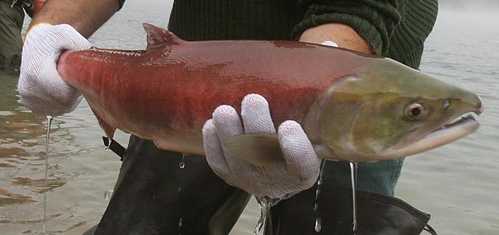forum
library
tutorial
contact

Salmon Hatchery Reform
by Andrew MarksSeattle Times, May 3, 2009
|
the film forum library tutorial contact |

|
Salmon Hatchery Reform
by Andrew MarksSeattle Times, May 3, 2009 |
It's about responsibility'
 Hatcheries have been utilized by public, private and tribal sectors for many years. Billions of dollars have been spent on spawning habitat and fish passage over dams. Despite all of these efforts, we are still no closer to recovery of the runs of endangered salmon and steelhead in the Northwest than we were when those runs were first listed as endangered.
Hatcheries have been utilized by public, private and tribal sectors for many years. Billions of dollars have been spent on spawning habitat and fish passage over dams. Despite all of these efforts, we are still no closer to recovery of the runs of endangered salmon and steelhead in the Northwest than we were when those runs were first listed as endangered.
In his recent guest commentary ["Hatchery reform comes to the Columbia River," Opinion, April 24], Jim Waldo accurately reported that the Hatchery Scientific Review Group (HSRG) tells us not only why recovery has not been achieved, but also how recovery can finally be achieved. It tells us how hatcheries must be used and operated.
HSRG also defines how we need to fish to both remove greater numbers of hatchery fish to keep them off the natural spawning beds and to protect the wild fish so they can reach the spawning beds. It is called mark-selective fishing. The unacceptable alternative is to stop producing hatchery fish, and allow no fishing that would kill the few remaining endangered wild fish.
The HSRG recommendations are not about who gets to kill the fish, or even how many fish get to be killed. The arguments are not, as many would like to make them appear, tribal versus recreational versus commercial fishermen. The fact of the matter is that we, all fishermen and hatchery operators, have done a poor job of stewarding recovery of ESA stocks.
Waldo does a good job of stating facts, but stops short of identifying that we all bear the responsibility of recovering these endangered runs. HSRG tells us how to do that. It is not a management or allocation issue; it is a moral and ethical imperative, and a burden shared by all who value the resource.
It is now known that without the benefit of wild stock to enhance the hatchery stock, eventually the hatchery stocks will also die out, with no option for recovery. Conservation trumps allocation and benefits everyone. It is time that all fishermen employ mark-selective gear and methods. It is time we all take responsibility for protecting wild fish, and for selectively catching more hatchery fish.
While U.S. v. Washington is the law of the land, the Endangered Species Act is also the law of the land, and before there can be comanagement of a resource, there has to be a resource to manage. If we fail in our responsibility to do what it takes to achieve recovery of these ESA stocks, we place the very resource itself in peril.
learn more on topics covered in the film
see the video
read the script
learn the songs
discussion forum
